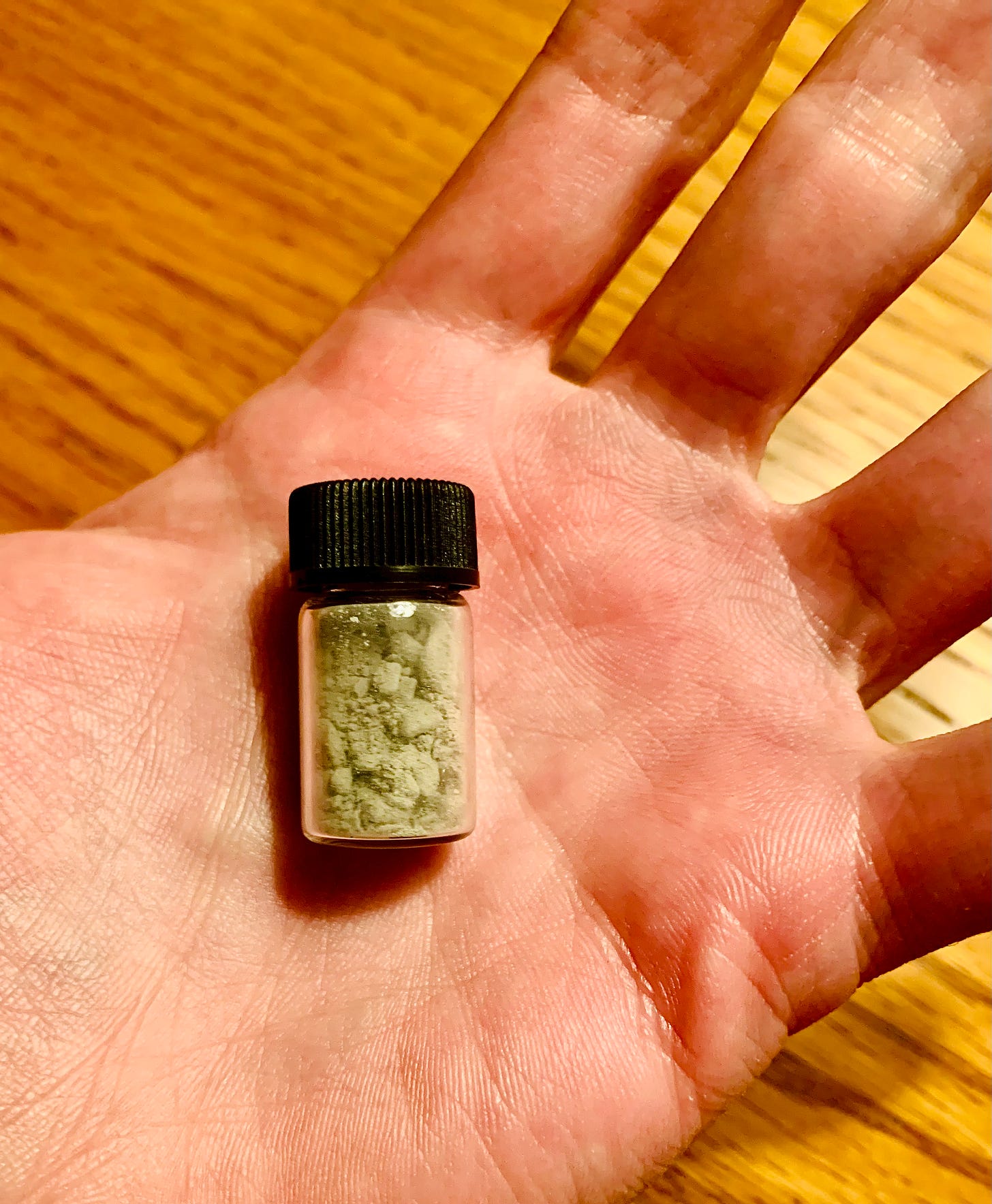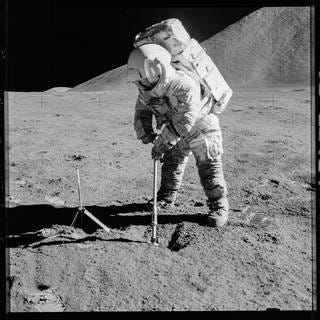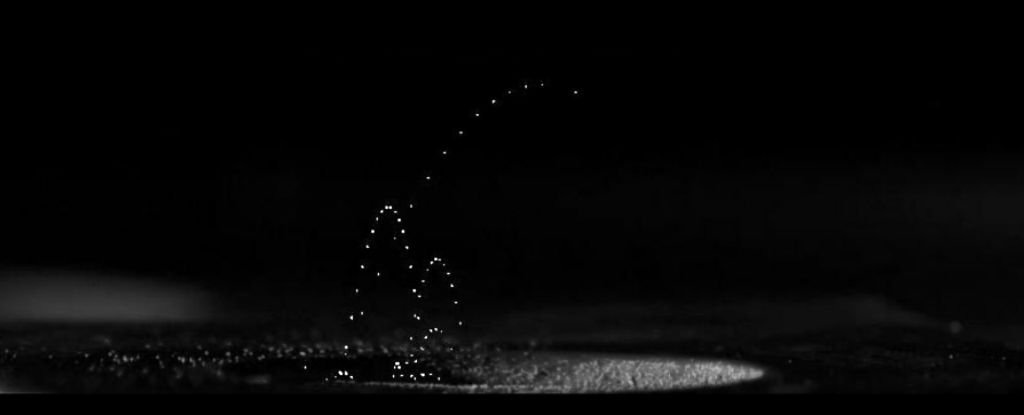COLD MOON 2022
21 Grams of Moon Dust
Dear Lunatics,
The closest I’ve ever come to holding the Moon in my hands has been during summer night swims, when the Moon’s reflection darts around me like a silver fish, sliding off my palms and minnowing between my fingers.
Tonight is the Cold Moon, and it’s too frigid for a dip in the town reservoir.
But I’m holding the Moon in my hand.
Or at least a vial of lunar crumbs.
They were collected at a site in Mauritania where a lunar meteorite crash-landed. (Every day, the Earth gains an estimated twenty tons through the precipitation of dust from space.)
The seller informed me that I could add my newly acquired moon dust to tattoo ink and permanently embed it in my skin.
I’ll have to think about that, I said.
First, I wanted to smell it.
According to the Apollo astronauts, who were the first humans to come nose to nose with moon dust, it smells like spent gunpowder. A few astronauts said overdone steak or burnt almond cookies, but most agreed on gunpowder.
(Apparently, Sagittarius B2, a colossal dust cloud at the heart of the Milky Way that contains formate, smells like raspberry vodka—or it would, if anyone could get close enough to take a sniff.)
But before I popped the cap off my nip of moon dust, I decided to review what I know about this otherworldly material.
It’s easy to forget just how little we understood about moon dust 50 years ago.
When Neil Armstrong was descending that famous ladder, and everyone in the world was glued to their television sets to see the first human foot land on lunar dust, one woman in Ohio was holding her breath.
It was Viola Armstrong, Neil’s mother, and she was convinced that her son was about to be swallowed whole.
It wasn’t an unreasonable fear.
Before the Apollo missions, scientists testified to Congress that the Moon’s soil could be a type of quicksand.
For all NASA knew during its live broadcast, the entire world may have been about to witness an American astronaut sink and disappear into a pool of grey sludge.
Fortunately, the lunar surface crunched under Armstrong’s boot and his mother, 240,000 miles away, exhaled.
By all reports from the Apollo astronauts, moon dust is as soft as snow, as clingy as a T-shirt fresh from the dryer, and totally dry (the Moon is a 4-billion-year-old desert).
We now know it’s mostly made of glass.
Moon dust is the product of so-called “lunar gardening,” a heavy metal version of landscaping. Over eons, meteorites have slammed into the Moon’s surface, scattering chunks of mantle, which are then ground over billions of years of exposure to cosmic radiation into a layer of chalky powder.
Moon dust is not like Earth dust.
Without water and wind to dull its edges, moon dust is as jagged as coral and, according to the planetary scientist Philip Metzger, as sticky as “the fine hairs on a gecko’s feet that allow it to walk up walls.”
No wonder NASA considers it the greatest environmental threat to moon visitors.
During the Apollo missions, moon dust scrambled electronics, scoured camera lenses, eroded bearings, and caused arthritis in equipment joints. Even the vacuum cleaners NASA specially designed to clean the moon dust were quickly asphyxiated.
Gremlins, those malevolent mythical creatures that World War II fighter pilots blamed for aircraft malfunctions, have nothing on moon dust.
Worse, moon dust assaulted the astronauts: it jammed their zippers, obscured their face shields, and bore through the three layers of Kevlar-like armor on their boots. It even degraded the seals in their spacesuits and caused air pressure leaks.
After a walk on the moon, Apollo astronauts would return to their lunar lander as sooty as coal miners. Squirming out of their soiled suits, they would find their long johns grimy with dust. At their wits end, the Apollo 12 crew stripped off all their underwear and plummeted back to Earth in the nude.
On the moon, the dust is impossible to avoid.
It can levitate.
With no protective atmosphere, the lunar soil is so electrostatically charged by solar winds that the dust can float up to sixty miles above the surface.
The most bizarre lunar observations—“moon fountains,” “moon storms,” and “twilight rays” that glow at sunrise and sunset—are all the result of light reflecting off hovering moon dust.
Harrison Schmitt, the last living man to walk on the moon, turned the fine-grained moon dust to his advantage. Instead of clumsily hopping around like his fellow astronauts, he glided over the surface as if skiing. He’s recommended that future astronauts be given cross-country skiing lessons. (He’s also on record recommending the Taurus-Littrow valley as a potential location for a lunar ski resort.)
Of course, Harrison Schmitt’s experience with moon dust wasn’t all positive.
After tracking some of it into the Challenger living quarters, he suffered an attack of “lunar hay fever.” Symptoms included watery eyes, sore throat, and uncontrollable sneezing. After the splashdown, a flight surgeon handling the Apollo 17 spacesuits had a similar reaction.
Some have suggested that we begin screening potential astronauts for moon dust allergy.
(Just one more reason I’ll never make it to the moon: I’m allergic to everything—animals, plants, molds, dust. I remember noticing, during my allergy test, that I only reacted to trees in the Northeast. Already dreaming of hiking through redwood forests, I asked my allergist if I should relocate to the West Coast, since the tree species of California had no effect on me. But the doctor shook his head. “You’d just become allergic to those trees.”)
Harrison Schmitt, the astronaut allergic to the moon, considers moon dust to be a kind of gold dust.
He believes that helium-3, an isotope plentiful in moon dust, could provide a nuclear fuel for fusion reactors that is more efficient and safer than any material found on Earth.
I hope he’s right.
With twin energy and climate crises bearing down on us, humanity could really use a Deus ex luna.
But so far, the utility of moon dust is all speculation, and other scientists have labeled the idea “moonshine.”
Moon dust has been all over the news lately.
In May, scientists from the University of Florida were able to successfully grow thale cress—a cousin to broccoli, cauliflower and kale—in lunar soil, raising the possibility that astronauts could one day farm crops on the moon. (Though the researchers admit the taste of thale cress is gag-inducing.)
And in exactly three days, the Japanese startup ispace is sending a lunar lander to collect moon dust. (If you live in southeastern Florida, where the rocket is launching, expect sonic booms to wake you in the middle of the night.) Ispace is already contracted to sell its bounty to NASA—for a measly $5,000.
Why is the price so low?
Because the transaction’s true purpose is to set a precedent that private companies can extract and sell lunar resources.
Once that bag of moon dirt and that stack of $5,000 trade hands, the commercial exploitation of the moon will have begun.
But can I really be outraged as I sit here clutching my own tiny jar of moon dust?
Sure, mine rained down from the sky…but would I turn my nose up (figuratively speaking) at a vial of newly harvested lunar soil?
I’m trying to decide whether or not to open it.
I’m not going to smoke it in a pipe, but what if I just tasted a pinch of the stuff?
Would that be so dangerous?
It’s not like its Martian dust, which would burn through plastic like undiluted lye.
Still, I can only imagine my allergist’s face if I showed up at his office tomorrow morning, trying to explain between sneezes what I had done.
Before he left the moon, Apollo 17’s Eugene Cernan etched the initials of his daughter into the lunar soil. Without wind or rain on the moon, the initials will stay carved there until a meteor strikes—or, more likely, a mining company arrives.
So maybe I will visit that tattoo parlor after all.
John Keats’s name was writ in water; mine could be writ in moon dust.
See you all on the Wolf Moon!
—WD
Thank you for reading! If you enjoyed this post, please consider subscribing to this newsletter, which is as free as looking at the Moon.
And please consider sharing this post with some of your fellow Earthlings 🚀.









Nice one, Will...as always!
Nice! I'll have to forward this on to my daughter, who is working at NASA on Moon dust (well, anti-dust, really) systems.